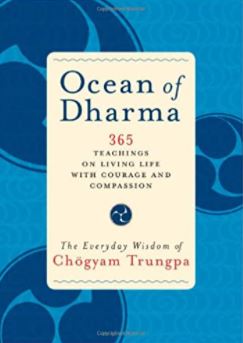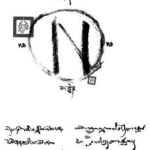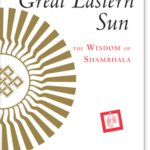

BASIC NO
From Chogyam Trungpa: Ocean of Dharma
Basic NO is accepting discipline in our life without preconceptions. Normally, when we say the word “discipline,” it comes with a lot of mixed feelings. It’s like saying “oatmeal.” Some people like hot cereal, and some people hate it. Nevertheless, oatmeal remains oatmeal. It is a very straightforward thing. We have similar feelings about discipline and the meaning of NO. Sometimes, it’s a bad NO: it is providing oppressive boundaries that we don’t want to accept. Or it could be a good NO, which encourages us to do something healthy. But when we just hear that one word, NO, the message is mixed.
Fearlessness is extending ourselves beyond that limited view. In the Heart Sutra, an essential teaching given by the Buddha, it talks about going beyond. Gone beyond, gate, is the basic NO. In the sutra, it says there is no eye, no ear, no sound, no smell — all of
those things. When you experience egolessness, the solidity of your life and your perceptions falls apart. That could be very desolate or it could be very inspiring, in terms of shunyata or the Buddhist understanding of emptiness. Very simply, it is basic NO. It is a real expression of fearlessness. In the Buddhist view, egolessness is pre-existing, beyond our preconceptions. In the state of egolessness everything is simple and very clear.

Warrior-King of Shambhala, Remembering Chogyam Trungpa,

Jeremy Hayward
The Big No arose some time ago when I was together with my Vajra Regent and several other students at the Kalapa Court, my house. When the Big No came out, I had found that everybody was indulging in their world too much. I had to say No. So I crashed my arm and fist down on my coffee table, and I broke it. I put a dent in it. Then I painted a giant picture of the Big No in the entrance hall of my house:
BIG No.

There was ink everywhere from that proclamation. The message was: From now onward, it’s NO. Later on, I executed another calligraphy for the Regent as another special reminder of the Big No, which he has in his office. That No is that you don’t give in to things that indulge your reality. There is no special reality beyond reality. That is the Big No, as opposed to the regular no. You cannot destroy life. You cannot by any means, for any religious, spiritual, or metaphysical reasons, step on an ant or kill your mosquitoes—at all.
That is Buddhism. That is Shambhala. You have to respect everybody. You cannot make a random judgment on that at all. That is the rule of the king of Shambhala, and that is the Big No. You can’t act on your desires alone. You have to contemplate the details of what needs to be removed and what needs to be cultivated.
On the whole, gentleness is the rule in the Shambhala kingdom. It is actually much more terrifying than kindness, to your surprise. When you are gentle, there’s no room for hostility. We like being hostile; we want to be perked up and energized by our negativity. But in Shambhala, we never do that, and we shouldn’t do that. However, with Shambhala vision, there is festivity and joyousness, because we are
not totally in the dungeon of our neurosis. That cheerfulness is what we call the Great Eastern Sun. The model for the Great Eastern Sun is the sun that shines at
ten o’clock in the morning. The sun is no longer the early morning sun, and it is no longer a teenage sun. The sun is about to be full, but it’s not quite full. That ten o’clock sun is the Great Eastern Sun.
You may hear what I’m saying and think that it’s true. But you have to practice it; you have to do it, sweethearts. We can’t just issue messages of philosophy all over the world. We are capable of actually sending up a satellite that would beam down Shambhala or Buddhist slogans twenty-four hours a day. What good would that do? We have to get ourselves together.
Please regard yourself as part of the Shambhala kingdom. People say, “Another day, another dollar.” But from the Buddhist point of view, we say, “Another breath, another life.” We should be proud and very pleased that we can hear these teachings because we have not dropped dead yet! Beyond that, I hope you will have a good time, enjoy your life, and appreciate the information you’ve received.
A few years ago, His Holiness Karmapa was visiting the United States, and we were working with many different people and organizations to finalize his tour of the country. A Buddhist studies’ professor told one of the people working on the arrangements that we should never refer to His Holiness as a king. That is completely missing the point, and it’s totally wrong. I am going to write the professor a letter, basically saying exactly that, but I may not put it that politely. We should do things in a humble manner and in a glorious manner, and both of them come together. There’s no conflict between the two at all. We need to develop a humble manner, meaning a sense of decorum, without arrogance. But when we invite friends into our home, we shouldn’t be shy of showing our guests the silver.
Shambhala vision is not based on the creeping humbleness and
reasonability of democracy.
I hope that we can mingle ourselves together. Please join the Shambhala world. You invite me; I invite you. The world is not all that small. There’s a giant world. I appreciate your kindness and goodness. Even after the death of our leader, His Holiness, you have actually made my life longer.

GREAT EASTERN SUN, The Wisdom of Shambhala
Chapter 12
THE BIG NO
by Chogyam Trungpa
Thirty years ago (January 8, 1979 to be precise) Trungpa Rinpoche proclaimed the Big No. Here to commemorate thirty years of NO, is Chögyam Trungpa’s commentary on the event and its meaning from Chapter 12 of GREAT EASTERN SUN, THE WISDOM OF SHAMBHALA.
© 1999 by Diana Judith Mukpo. Used here by arrangement with Shambhala Publications, Inc.
from The Chronicles
Deepening Practice, Shaky Leadership
IN THE MIDDLE of January, a birthday_ party was held for Ken Green. Toward the end of the party, Rinpoche called together the Directors for a short meeting we all crowded into the toilet, the only private place in the house at that moment. There he told us, sternly and forcefully, that the Regent needed to have more boundaries around his behavior and that we should take care of it.
Since 1976 he had manifested brilliantly as a teacher of Buddhism and in that sense was coming up to the expectations of him as Rinpoche’s lineage holder. Yet he had not curbed his wild behavior, and in particular his involvement in the gay scene. It was not his gay activities as such that was the problem-Rinpoche never had a problem with that but rather, perhaps, his recklessness. And, indeed, it was this recklessness in the end that caused his tragic and untimely death, as I will recount in the Epilogue.
That night we were called to a meeting in the Court, which the Regent joined later-someone was sent to fetch him from a party that he had gone on to after Ken’s birthday celebration. While we were waiting for him, Rinpoche told us
clearly that no one else could have been his Regent, and asked each of us what we thought was the source of the Regent’s difficulties. I was the last to speak and said that the quality that made him the Regent–a purity that somehow was not caught in worldly things-was the same quality that was giving rise to the problems; he sometimes didn’t seem to care how he behaved, I felt, and whether he was endangering himself or going against conventional norms in a harmful way. Rinpoche commented, “Your answer was the best.”
He instructed us to challenge the, Regent along the lines of the committee that Rinpoche had told me about in retreat, but we were not. effective in getting through to the Regent and soon Rinpoche ended that part of the evening.
After we left the Court, Rinpoche continued with a smaller group to try to get through to the Regent that there was a potentially serious problem. Rinpoche himself described this incident three years later at a Shambhala Training Level Five program.
The Big No arose when I was together with my vajra regent and several other students at the Kalapa Court, my house. When the Big No came out, I had found that everybody was indulging in their world too much. I had to say No. So I crashed my arm and fist down on my coffee table, and I broke it. I put a dent in it. Then I painted a giant picture of the Big No in the entrance hall of my house: BIG NO. There was ink everywhere from that proclamation. The message was: From now onward, it’s NO. Later on, I executed another calligraphy for the Regent as another special reminder of the Big No, which he has in his office. That No is that you don’t give in to things that indulge your reality. There is no special reality beyond reality. That is the Big No, as opposed to regular no. You cannot destroy life. You cannot by any means, for any religious, spiritual, or metaphysical reasons, step on an ant or kill your mosquitoesat all. That is Buddhism. That is Shambhala. You have to respect everybody. You cannot make a random judgment on that at all. That is the rule of the king of Shambhala, and that is the Big No. You The Regent clearly had a certain level of realization of emptiness and the joy that goes with this, and he was brave and forthright in expressing this understanding. But at any level of realization up to the very highest, there is always the possibility of going astray into ego-trips and misuse of the dharma and of our less-than-perfect understanding of it. We, as well as the Regent, were being warned by Rinpoche to “watch out” as he so often told us. It was a powerful night, and a valuable lesson to us all. This split between the two aspects of the Regent’s nature began to manifest increasingly and I will, say more about this as the story unfolds.